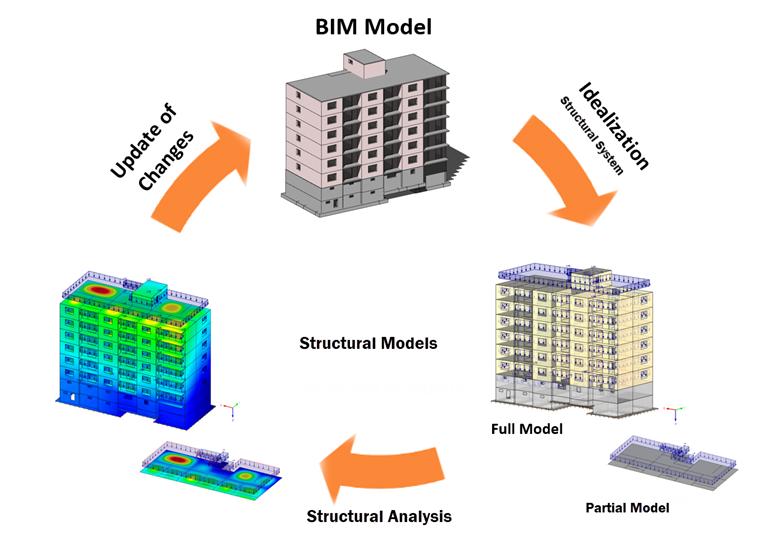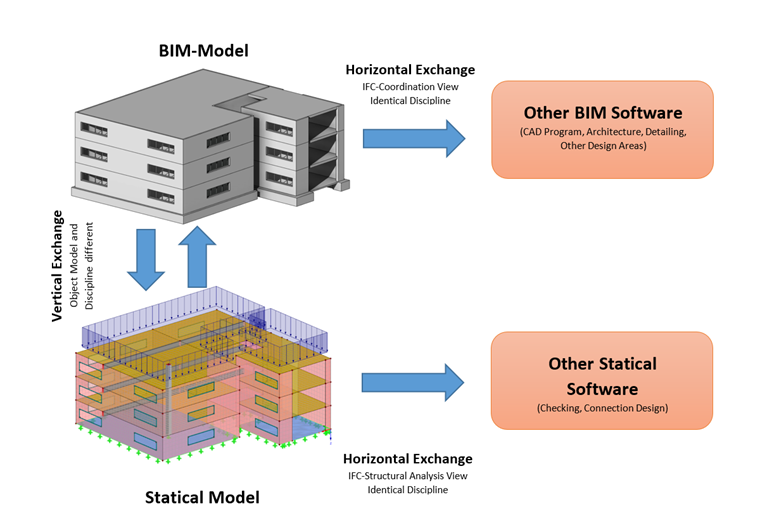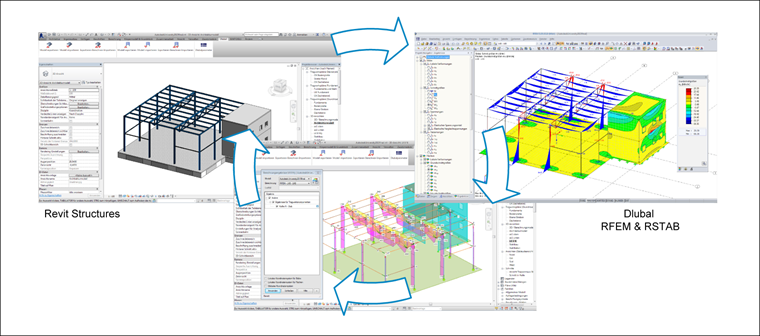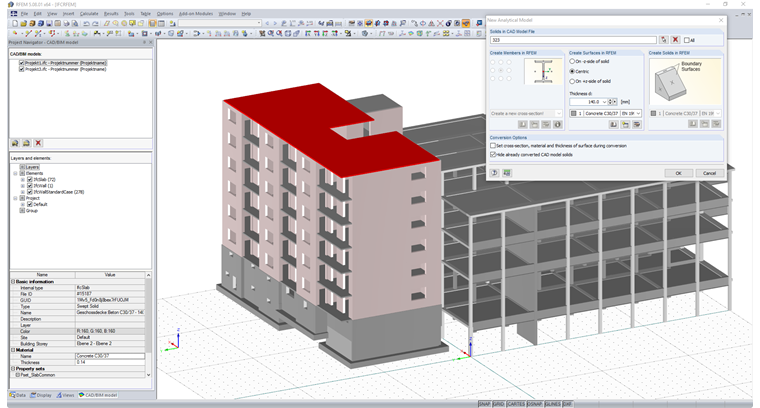3D models have been created for more than twenty years (for example, in steel construction), and they are used to derive 2D engineering data automatically, or to access and control production machines directly via NC data. Likewise, structural calculations on 3D models are state of the art. Due to the generation of digital models, the main challenges faced by construction software are data exchange issues and how these models can be used in a time-efficient manner in the software of different technical planners. Not only do geometric and physical models play a role, a number of other models contain more than the physically visible component information. One such model is the structural or analytical model, which contains mechanical material properties, boundary conditions, or load assumptions; that is, things that cannot be read immediately from a purely physical architectural model. These differences result in difficulties in the data exchange of BIM models in structural engineering. The expectations of BIM in structural analysis are enormous. The task for construction software manufacturers is just as large. In this article, we will explain the basic issues of data exchange, then present practice-oriented and tested solutions.
Structural Design in BIM Process
Building Information Modeling is based on a holistic view of a structure’s life cycle; this includes the initial idea and design planning (architect, building owner), the detailed design and final planning (engineers), and the building’s operation and demolition. Among other things, the objective is to optimize costs over the structure’s life cycle. The structural design itself is only a small part of BIM, and its impact on the structure’s costs is usually of secondary importance. Therefore, the great "revolution" of BIM has more influence control by the architect. Nevertheless, structural engineering plays a significant role in a relatively short period of the final planning. Design determines the feasibility of a particular structural concept, and is a milestone in the planning process, as other services could be delayed without proper design. It also has a strong influence on further planning reliability and thus on the associated costs for the necessary changes. In short: structural analysis, including any subsequent changes, must be efficient and reliable. The current three-dimensional BIM models can provide valuable data input or means of communication and better understanding in regard to structural engineering.
BIM Model and Structural Model
Generally, BIM models include information about the geometry, materials, and semi-finished products of a building. They describe the purpose of the building and can also provide information about the assembly time, for example. BIM models are suitable as a visual communication tool for all parties involved in the construction; they serve as a tool for material and cost determination, and lastly, they help to avoid planning errors due to collisions of individual components or subsections. Data exchange refers mainly to a parametric description of the exact building geometry. Structural components are described by boundary surface models or extrusion areas that result in a solid.
In contrast, the focus of structural models is on the mechanically correct projection of the support structure. The geometry is simplified and reduced to those structural components relevant for structural analysis. The detailed description of the geometry is only used when necessary, and the calculation time will inevitably increase. Columns and beams are calculated as members (1D elements), while walls and ceilings are calculated as slabs and plates (2D elements). These member and surface elements can also be combined with one another in the 3D structural model. In order to calculate these idealized models numerically, it is necessary to join all structural components together and to verify the transition conditions. However, due to the component reduction from solids to center lines (in the case of members) and middle planes (in the case of surfaces), the automatic intersection is not always available.
Further essential components of the structural model include the following:
- Support and hinge definitions
- Mechanical properties of materials and cross-sections
- External loads (wind, snow, imposed loads, and so on) and load combinations
- Effects of seismic activity or other accidental actions
- Design specifications
- Linear and nonlinear calculation methods and analyses
It is impossible to infer the structural model from the pure geometry information of a BIM model without the intervention of a qualified engineer. Geometrically identical modeling would also require representation as a solid model in structural engineering. However, even with the currently available computing capacity, it is unthinkable to calculate a building as a solid model.
Practice-Relevant BIM Exchange Scenarios
You can distinguish the data exchange between software applications of the same discipline and those of a different discipline. If data are exchanged between architecture software or construction software, the objects are the same, and the information content and its data models will be very similar in both programs. The different software applications can process the information directly and translate it into software-specific intelligent objects. This is also known as horizontal data exchange.
If data are to be passed to another discipline, such as from architectural software to structural analysis software, the focus is then on a different view of the data, and only supporting components such as columns, walls, trusses, or plates would be considered. The required additional information, such as the location of the structural lines of action, elasticity of the element connections, or precise mechanical details of materials and cross‑sections, will still be missing. This is also known as vertical data exchange. If you are within one discipline, you can easily avoid possible data loss or interpretation errors. For BIM in structural engineering, vertical data exchange is often used, since the structural model is usually generated from the architectural model, as the architectural model is typically available. However, the transfer from one structural analysis software to another also requires verification of structural calculations.
The most important scenarios can be summarized as follows:
- Architecture → structural analysis → construction
- Structural analysis → architecture for data synchronization of changes after the structural calculation
- Structural analysis → review of statics
- Optional export of entire structure or substructures
- Optional update of materials, thicknesses, and cross‑sections (bi‑directional), and return of the calculation results
There are various options for data exchange file formats. The IFC format as a global standard plays a special role. It is divided into different views and each discipline has its own view. The main view is the Coordination View, where the individual software products can be certified. When considering the IFC format without specifying the individual views, the Coordination View is typically used by default. This is supported by most architectural programs. In contrast, the Structural Analysis View for structural engineering includes a description of the structural model, loads, and load combinations. This view is currently not certifiable and is only supported by a limited number of structural analysis programs. Although defined as a standard, the IFC format can generally be interpreted in various ways; therefore, it is necessary to check the format with the relevant software’s data to achieve successful data exchange.
In addition to the IFC format, you can use the established file formats such as DXF/DWG, Product Interface for Steel Construction, or other text‑based applications. Direct interfaces also play an important role. They do not have any exchange files, as the individual programs communicate directly with one another via application programming interfaces (APIs).
Key Factors for Successful Data Exchange
The fundamental issue is to clarify which exchange scenario is available. If you are familiar with the individual software products, you may be familiar with the supported interfaces. With this in mind, it is necessary to perform the targeted exchange tests using models of a manageable size. Material and cross‑sectional properties often require further attention. Each software generally provides individualized structural engineering databases that contain all standard-dependent parameters. These databases are correlated to one another in "mapping files", which are simple tables of the associated descriptions. These mapping files are partially provided by the software developer. We recommend unifying and integrating these files according to the programs used for your application.
There is also BIM software, which already includes an analytical model (structural model) in the architectural model. The advantage of this software is that both models overlap and reference each other, so these models can be analyzed efficiently and easily. In addition to the system data, load specifications are possible. When using this software, you must build both models accurately. Appropriate coordination between all parties involved is necessary. The person who conducts the model editing is often not from the same engineering office, and the issue then becomes who settles the costs for the interdisciplinary models, and who is responsible for precision and accuracy. This must be arranged in advance. Without doubt, there is great opportunity for BIM and it continues to be recognized by well‑known firms. If the entire planning chain can be created, the BIM models can be prepared optimally, at an early stage, and used later for the structural analysis.
The support of various data formats is an important aspect in choosing the right software. The description in the existing data format must be transferred into the objects specific for this software. Consideration of the visualization or data model reference alone is insufficient for structural design and can only contribute to visual checks. If the software can import several models and transfer them into the correct data object model, this may enhance the flexibility significantly, and the chances for successful and effective data exchange are increased. This is a key success factor when the IFC Coordination View files are used in the structural analysis software.
Regardless of additional effort, programming of simple proprietary tools for data exchange should always be included at the outset. This allows the efficient transfer of additional information in the form of parameters. For example, you can display items of a structural model in BIM software, communicate possible modifications, or implement company‑specific workflows in the software. This requires all software products involved to have the corresponding APIs operated by conventional and simple programming languages (VBA, C#, and so on).
Key success factors for successful and efficient data exchange include the following:
Generation of BIM Model with Regard to Structural Design
- Early involvement of the structural engineer and consultation of the handover time and content
- Setting standards for materials and cross‑section descriptions (mapping tables)
- Functional and consistent modeling of structural components (columns, beams as member objects, walls, plates as surface objects)
- Modeling walls, plates, and columns in sections and levels
Determination of Scope and Content of Data Transfer
- Who creates the idealized structural model, and what software do they utilize (BIM or structural analysis software)?
- Will only the geometric dimensions and structural lines of action be transferred, or also other structural properties such as supports or hinges?
- Who defines load cases, load combinations, and loads?
- Who is authorized for certain changes: Adding or removing structural components, or defining the cross‑sections and thicknesses of the components?
- How and when will the potential automatic model alignment be performed?
Defining Working Phases
- Who works on which model space, and when?
- Avoid editing the same components simultaneously when possible
Testing Exchange Scenarios and Using Data Exchange Formats and Interfaces
- Does the supported BIM and structural analysis software provide the same interfaces, and to what extent?
- Performing tests on manageable models using defined exchange objects
Binding Rule to Make BIM Models Available
- Preferably in several formats (IFC, proprietary file format of the software, DWG/DXF, SDNF, STEP, or other formats)
- Extending the possibilities for data exchange and allowing the verification and comparison of models
Summary
Structural engineering takes on a significant role in Building Information Modeling. Due to the increased application of BIM-oriented planning methods, new digital process chains provide the opportunity to increase efficiency. The BIM model and the structural model are different in nature, and the derivation of structural models from BIM models is not always automatic and clearly possible. An efficient planning process regarding structural engineering requires the involvement of a structural engineer at an early stage, as well as respecting the aspects of structural engineering and data exchange when creating a BIM model. The software used should allow the transfer of existing parametric geometry information of the intelligent objects specific to the software through the use of corresponding interfaces. Finally, a good data exchange strategy in compliance with the software used allows you to integrate structural design in the BIM process effortlessly.



